“Woof!” The sound sent a chill down my spine. I looked over my shoulder to see a large, hungry looking grizzly bear watching me intently from directly across the river. I turned my head momentarily to warn Mike.
“Bear!” I whispered. As I looked back at the bear, he stood up on his hind legs and continued to stare. When I reached for my camera he swapped ends and crashed into the brush.
“Whoa! That was cool, in a terrifying sort of way,” I said to Mike. He agreed.
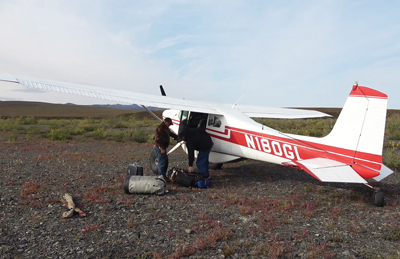
Unloading the bush plane.
Three days earlier on August 19th our bush pilot had flown us into the middle of nowhere. He would pick us up ten days later. Two hundred miles north of the Arctic Circle, flying around looking for caribou, we spotted a few small isolated groups and one large grizzly before landing on a gravel bar next to a river slightly north of nowhere. After unloading our gear, we watched the bush plane take off. A profound feeling of isolation washed over me as the aircraft disappeared over the horizon. Mike Misch and I both know that feeling well, for this was our 13th Alaska wilderness hunt together.
We made camp in willow brush about 80 yards from the river where we’d have some protection from the wind. We always set up two tents 20 yards apart: a good dome tent to sleep in and one small tent for food and cooking gear. Our Number 1 Rule is: No food allowed in the sleeping tent! If a bear comes into camp we would rather have him raid the food tent than crawl in with us while we sleep. Just the thought of a big grizzly sitting on my chest munching candy bars in the middle of the night is enough incentive for me to follow that rule.
We decided to climb up a nearby ridge and do some glassing, since we were not allowed to hunt the same day as our flight. As we walked along the river we noticed quite a few dead salmon, but we also saw a lot of live ones swimming upstream. I had hoped the run would be over and the bears would be gone, but the evidence said otherwise. After an hour I spotted three dots moving along a ridge a mile to our west. I zeroed in on them and discovered they were three grizzly bears, the last thing we wanted to see. We didn’t want bears chasing away our caribou, and we didn’t want bears chasing us away.
On our first day of hunting, it naturally rained all day. We stayed close to camp. Every time the rain let up, we would go out and sit by the river. No caribou showed up, but we saw two more grizzlies on a ridge about a mile downstream.
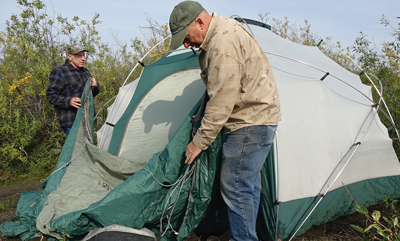
The author, left, and his friend Mike Misch setting up the sleeping tent.
The next morning, we got up at 6:00 a.m. It had already been light for three hours. During August this far north the sky doesn’t get dark until midnight and becomes light again at 3:00 am. After breakfast, I went upstream about 100 yards and built a makeshift blind. About 7:00 a.m. I spotted movement on the far side of the river about 200 yards upstream. A sow grizzly and three small cubs were patrolling the river’s edge looking for salmon. I watched and videoed them for 30 minutes until they melted into the willows. An hour later I saw another grizzly a mile downstream. Then, 14 caribou crossed the river 200 yards downstream, but there were no bulls in the group. At noon we returned to camp for lunch. After our meal we walked down to the river to wash dishes. When we turned and started walking back to camp, I heard the “Woof’!” that began this story.
After Mike re-acquired his ability to speak, we discussed what had just happened. I don’t know how long the bear had been there. He probably didn’t notice us until we started walking. All of our weapons were back at camp 80 yards away, including our bows. After this wake up call, we realized our defensive game needed some work.
The next morning broke clear and cold. We hunted until 7:00 p.m., but saw only a few scattered groups totaling about 30 caribou, but no mature bulls. We returned to camp for supper. After a hearty meal, we walked down to the river just in time to see a cow and calf come across and pass within 50 yards of our camp. Since we still had four hours of daylight remaining, we continued hunting. I was only on stand for 30 minutes when I saw movement across the river. A big shaggy blond sow was leading a pair of chocolate brown yearling cubs. While mama plodded on down to the river, the cubs entertained themselves by uprooting willow bushes that hung down from the top of the eroded river bank. It appeared that they were doing this just for the fun of it. I got some great video of them as they chased salmon, ate salmon, and fought over salmon. I named the spot “Bear Corner.”
A little while later I saw Mike approaching unexpectedly. He had a little more spring in his step than usual, which led me to believe he might have shot a caribou. When he got close enough he said, “I just had a grizzly encounter!”
“Yeah? So did I,” I replied.
“Well, this one is coming this way!” he shouted. “He’s right behind me! I’m gonna grab the shotgun!”
He sprinted to our camp 50 yards away and quickly returned with the firearm. I wasn’t used to seeing Mike move with that kind of speed. It’s amazing what a little shot of adrenaline will do for you.
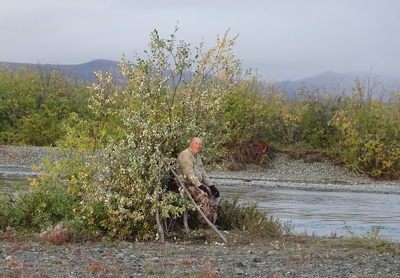
Mike sitting on a bench he built, watching a caribou crossing.
He had been sitting next to the river a quarter-mile downstream where the caribou had crossed the day before. The bear had approached from downstream on the other side of the river. Mike decided to stay put unless it swam across, which would put the bear right in Mike’s lap. About 75 yards out the bear did indeed start swimming across. Discretion being the better part of valor, Mike slipped out of his hiding place and beat it back to my location.
There was no safe place for us to go, with no trees to climb that far north and no guide with a backup rifle. The wind was in our faces so there was no chance the bear would smell us, so we decided to wait out in the open and hope it would see or hear us and run away. We didn’t have long to wait. Two minutes after Mike’s return, the bear popped out of the brush 100 yards away and coming straight at us. When the bear closed the distance to 60 yards, it turned toward the river. After a few more steps it stopped for a second looking nervously toward the river, then jumped back and changed course as if detouring around something. The bear took a couple of more nervous steps and then spun around and headed downriver like a scalded dog.
“Holy cow! Did you see that?” I exclaimed.
“I did. But why did he spook?” answered Mike.
When we walked over to the river’s edge, the reason became clear. There on the ground lay Mike’s filter pump. He had used it a couple hours earlier and then left it there. The bear had first seen the pump and then smelled Mike’s tracks. Then it suddenly appeared again downriver, a quarter mile away and still running.
The next morning Mike re-visited “Swimming Bear Crossing,” as we now called it after the previous day’s adventure. Two small groups of caribou crossed a half-mile farther downstream. I decided to go down there and investigate. A little while later Mike came down to visit me, and while he was there 30 caribou crossed at the spot he had just vacated. At noon I went back to camp to make sandwiches and get another camera battery.
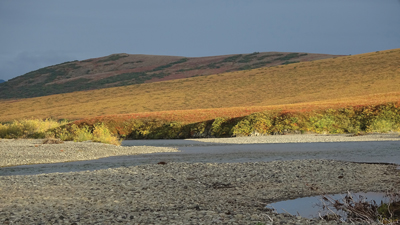
The view looking over Two Bull Crossing. This was the busiest spot for caribou traffic.
While I was gone a small group of caribou including two large bulls crossed right in front of Mike on a route that would bring them within 10 yards of his blind. A smaller bull led the way but Mike had eyes for the second bull, which was much larger. He let the smaller bull pass at six yards and prepared to shoot the second one. However, by the time the big bull got into shooting position the first one was far enough past Mike to get his scent. Mike could see that the bull was about to blow out and simply rushed his shot. His arrow flew harmlessly over the bull’s back.
This was my typical caribou luck. I was away no more than 30 minutes. During the other 14 hours that I sat in my blind that day, I never saw a single mature bull.
The next day we watched 40 bulls swim the river back at “Two Bull Crossing.” Then I noticed something else in the water. Another grizzly had joined the party, but it took off as soon as it winded me. The next day was foggy with low visibility for the first couple of hours. All was quiet until some cows and calves crossed about 25 yards from me. That evening, Mike suddenly appeared doing the “Grizzly Bear Shuffle.”
“There’s another bear coming this way,” he said. “It’s a big one!”
“Great!” I said. “I haven’t had any excitement all day!”
We watched as the bear plodded along, occasionally picking up a dead salmon. Then it turned east following another stream and we thought we’d seen the last of him. Mike wandered a few yards up the trail clearing branches. Suddenly the bear reappeared, heading right for us. “He’s coming back Mike!” I said.
He answered, “Okay!” but when I turned to look back for him he was gone!
I decided to stand my ground. (I’ve always wondered why you’re required to hire a guide to hunt grizzlies, but it’s perfectly legal to be eaten by a grizzly without one.) Just as the bear got broadside, he stood up on his hind legs looking upriver. My pounding heart took a little jump, but the bear showed no desire to cross the river.
The next morning I was there again when another bear appeared downriver. It was like a replay of the previous day except this bear followed a parallel stream and never got closer than 100 yards. Three times he dove into the deep water completely submerged and once came up with a salmon flopping in his jaws.
That afternoon a bush plane landed by our camp. The pilot was looking for another hunting party that he had dropped off a few days earlier to float the river, but he couldn’t find them. We later learned that the hunters had shot three caribou the first day, but they never floated because the bears took their meat and tore a hole in one of the rafts.
When hunting in bear country you need to stay in good shape. While on this hunt I invented a new exercise based on our experiences here. I named it the “A bear is coming so I think I’ll scoot on outta’ here!” exercise. Mike was employing it again when I saw him the following evening.
“We’ve got three bears coming from downriver! I didn’t like the odds, so I bailed,” said Mike.
I said, “Goldilocks, I told you not to eat all that porridge this morning.”
“That was oatmeal,” he grumbled.
A sow and two full grown cubs as big as her waded out into the middle of the river and started fishing. One of the cubs caught a salmon but didn’t want to share. He left the river and started running with the salmon in his mouth, but to no avail. The other two soon caught up and a tug of war ensued. Once the salmon was consumed, they wandered off into the brush.
The next evening they appeared again, quartering toward us right across the river. I suspected they were headed for “Bear Corner” and wanted to get some more video, so we hoofed it down there and arrived just in time as the bears entered the water. A fussy eater, the sow would stop and smell each dead salmon, she but was shopping for something fresher. However, the cubs would chow down on every one they found. They especially liked the live ones though, and a fight would ensue whenever one of the bears caught one. They entertained me for an hour until they got downwind of me. The sow detected me first, stood up on her hind legs, and stared in my direction as the two cubs followed suit. The sight of those three bears looking for me felt chilling, but it served as a life lesson for the cubs from their mama: “Whenever you smell this scent, run!” And that’s what they did.
The next day our pilot arrived to return us to civilization, but not before one last adventure. The clear weather quickly turned to heavy clouds and rain as we approached the mountains. As we threaded our way between the peaks, the ceiling kept dropping lower and lower, forcing us to descend. I could see growing concern on the pilot’s face. When we got down to 800 feet, the pilot banked hard left and made a 180 degree turn. When we got out of the soup, we flew east a few miles but we were soon in the same situation. It was as if Alaska didn’t want us to leave, but she finally relaxed her grip and allowed us to land safe and sound.
We spent 10 days in the field and saw 23 bears, but only eight caribou bulls. I didn’t shoot a caribou, but I did come home with some “Unseen Trophies” (see TBM Jun/Jul 2004) and enjoyed some awesome scenery and many spectacular sunsets. The bear encounters, both terrifying and amazing, were the highlights of our hunt.
When I got home someone asked how my trip went.
“Great!” I replied. “I didn’t get eaten by bears and none of my flights crashed.”
He laughed and asked, “Why do you keep going back?”
“Because the beauty, the solitude, and the adventure feel so good when I get back home!” I answered with a grin.
Gary Olsen is a retired electrical contractor. He lives in Michigan with his wife Kathy, who sends him away on hunting trips whenever she “needs a break.” When not bowhunting, you might find him in his workshop carving his favorite subject, (you guessed it) bears!
Equipment Note
The author was hunting with a vintage Bear takedown recurve and cedar arrows with 4-blade Zwickey Eskimo broadheads. Mike was hunting with an Osage longbow that he made himself.




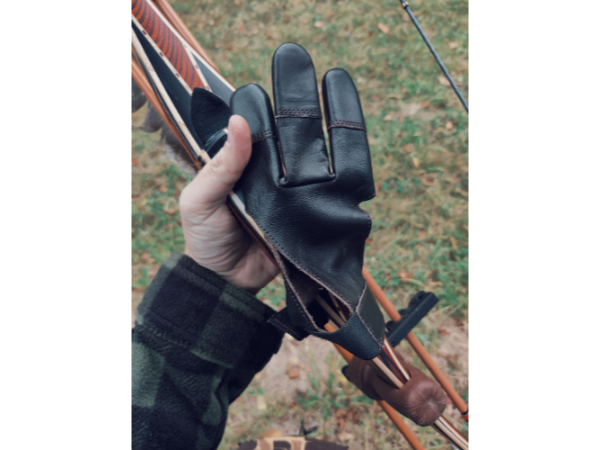


Leave A Comment